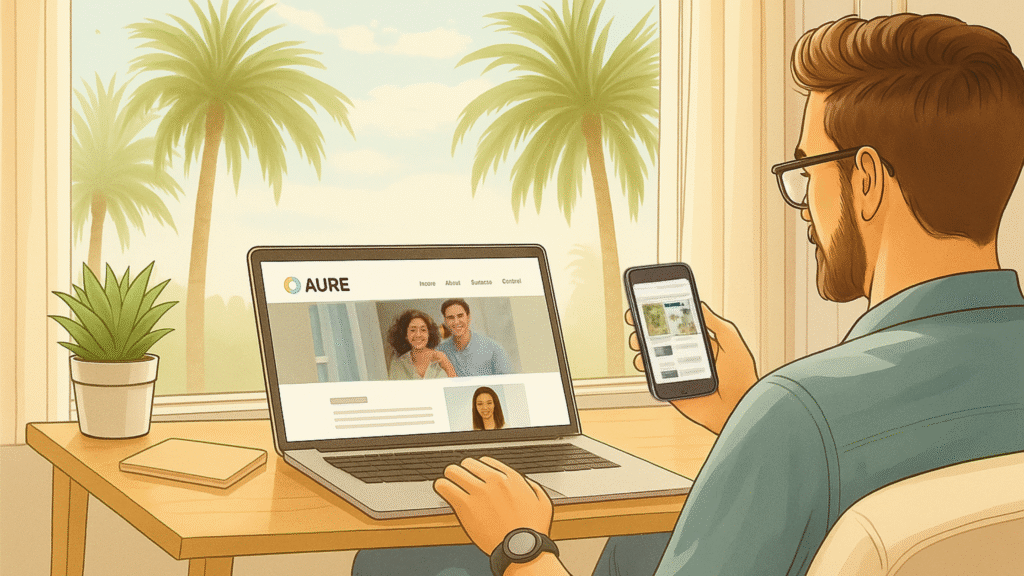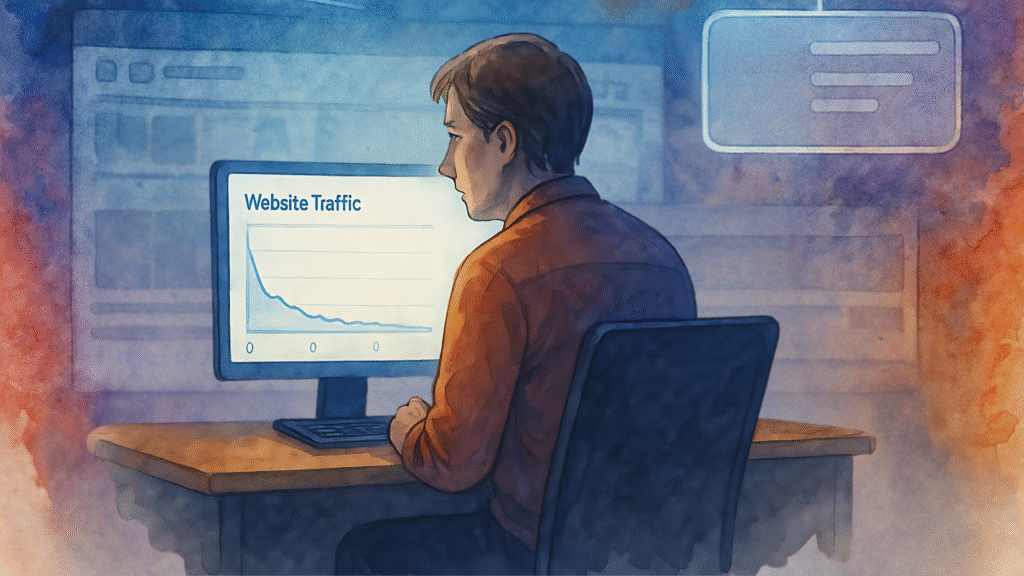You’ve got great photos. Your services are solid. Your Google Business Profile looks sharp. But here’s the thing: if your website takes more than three seconds to load, half your potential customers are already gone.
And it’s not just about losing visitors. A slow site actively hurts your search rankings. Google’s Core Web Vitals now include Largest Contentful Paint (LCP) under 2.5 seconds, Interaction to Next Paint (INP) under 200 milliseconds, and Cumulative Layout Shift (CLS) under 0.1 as key ranking factors. We’ve watched local businesses do everything right with their marketing, only to get buried on page two because their website felt like it was loading through molasses.
Let’s talk about why this happens and what you can actually do about it.
User Experience Isn’t Just Pretty Design
UX is basically how easy your website is to use. Can someone find your phone number without hunting through three menus? If they’re looking for your hours on their phone while sitting in traffic, will they find them before the light turns green?
Google notices when people bounce off your site immediately. And when that keeps happening, Google assumes your site isn’t helpful and stops showing it to people.
How Bad UX Tanks Your Local Rankings
Google’s algorithm looks at several signals from your website, and with mobile-first indexing now fully implemented across all sites, your mobile experience determines your rankings on all devices.
Page speed matters more than ever, especially on mobile. Most people browsing around Sarasota are on their phones, and Google’s Core Web Vitals now measure three critical metrics: LCP (loading), INP (interactivity), and CLS (visual stability).
Mobile usability is huge. If your site is a pain to navigate on mobile, you’re done. Since March 2024, Google replaced First Input Delay (FID) with Interaction to Next Paint (INP), which measures responsiveness across all user interactions, not just the first one.
Bounce rate tells Google whether people find your site useful. High bounces = lower rankings.
Trust signals like clear contact info and real customer reviews help, but they can’t save a frustrating user experience.
When someone visits your site and immediately leaves, that “bounce” signals to Google that your page isn’t helpful. Over time, you gradually slide down the rankings.
A Real Example from Right Here in Sarasota
There’s this landscaping company we know. Family-owned, been around for years. Their website looked decent on a computer. But pull it up on your phone? Disaster. Seven seconds to load. Tiny buttons you couldn’t tap without hitting three other things.
They were getting zero calls from their website. Zero. For a business that should be busy year-round in Florida.
After fixing the mobile experience and speeding things up, they started getting calls again. Lots of them. Turned out people were finding them, but the website was so frustrating they’d just call someone else instead.
Test Your Site (It’s Free and Takes 5 Minutes)
Don’t guess whether your site is slow. Check it with these Google-recommended tools:
PageSpeed Insights is Google’s tool. If Google says your site is slow, believe them. It now shows your Core Web Vitals scores including the new INP metric.
GTmetrix shows you exactly what’s slowing things down and how to fix it.
Mobile-Friendly Test tells you if your site works on phones. Spoiler: if it was built more than two years ago and hasn’t been updated, it probably doesn’t.
Run these tests on both desktop and mobile. The mobile score matters more for local businesses since Google uses mobile-first indexing for all websites as of 2023.
What’s Probably Slowing You Down
Nine times out of ten, it’s one of these:
Huge images. You know those photos you uploaded straight from your phone? Each one is probably 3MB. Your website shouldn’t have to load someone’s vacation photos just to show a picture of your storefront.
Too many plugins. WordPress sites especially get gummed up with plugins that seemed like good ideas at the time.
Cheap hosting. If you’re paying $3/month for hosting, you’re getting $3/month performance.
Messy code. DIY website builders are great for getting started, but they often leave behind a lot of digital junk.
For service businesses around here (HVAC, plumbing, landscaping), a slow website often means the difference between a phone call and a missed opportunity.
Quick Fixes You Can Do This Week
Compress your images. TinyPNG is free and works great. Your photos will look the same but load way faster. Use modern formats like WebP when possible.
Upgrade your hosting. If you’re on the cheapest plan, move up one tier. The difference is usually $5-10/month and totally worth it. Consider hosts optimized for Core Web Vitals like SiteGround or WP Engine.
Clean up your homepage. Remove anything that doesn’t help someone contact you or understand what you do.
Install a caching plugin. WP Rocket or LiteSpeed Cache can speed up WordPress sites significantly.
Here’s the thing: each page should have one clear purpose. If you want people to call you, make that obvious. Don’t make them hunt for your phone number.
This Stuff Takes Time, But Speed Doesn’t
Improving your overall user experience is a longer project. You might need to reorganize content, simplify navigation, maybe even redesign sections of your site.
But page speed? You can fix that this week. And when you do, you’ll probably notice more people sticking around and actually contacting you.
Voice Search Is Changing Local Business
Here’s something else to keep in mind: voice search is exploding. About 20.5% of people globally now use voice search regularly, and there are 8.4 billion voice assistants in use worldwide. That’s more voice assistants than people on the planet.
For local businesses, this is huge. 76% of consumers use voice search to find local businesses, and they’re asking questions like “plumber near me” or “best pizza in Sarasota.” 58% of people use voice to find local businesses, and these searches often result in immediate action like phone calls or visits.
The thing is, voice searches are different from typed searches. People talk more naturally: “Where’s the closest pharmacy that’s open late?” instead of typing “24 hour pharmacy Sarasota.” The average voice search result is 29 words long, and voice search results load 52% faster than regular search results.
If your website is slow, you’re missing out on this growing trend. When someone asks their phone for a recommendation, Google pulls from the fastest, most mobile-friendly sites first.
Get a Second Opinion
Want to know what real people think of your website? Post it in one of these local business groups:
Ask them to be brutally honest about what they’d change. You might be surprised by what they notice that you’ve gotten used to ignoring.
Need Professional Help?
If this all feels overwhelming, or you’ve tried these fixes and still aren’t seeing results, it might be time to bring in the experts. At Communica PRO, we specialize in helping Sarasota-area businesses optimize their websites for both speed and local search rankings.
We’ve helped dozens of local companies improve their Core Web Vitals scores, boost their mobile performance, and climb those search rankings. From technical audits to complete mobile optimization, we handle the complex stuff so you can focus on running your business.
Want to see how your website measures up? Contact us for a free website analysis and we’ll show you exactly what’s slowing you down and how to fix it.
The Bottom Line
Your website doesn’t need to be fancy. It just needs to work. Fast loading, easy to navigate on mobile, and clear about what you want people to do next.
Fix the speed first. Everything else can wait.







